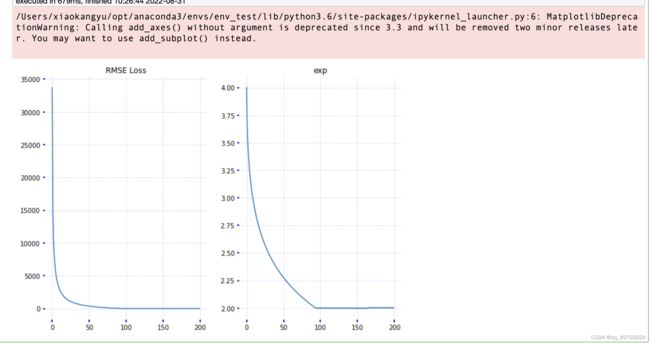tensorflow与pytorch转换总结
目前tensorflow代码只能自己手动转成pytorch代码,下面是自己的转换心得
比较案例
https://towardsdatascience.com/pytorch-vs-tensorflow-spotting-the-difference-25c75777377b
pytorch version1
import torch
from torch.autograd import Variable
import numpy as np
def rmse(y, y_hat):
"""Compute root mean squared error"""
return torch.sqrt(torch.mean((y - y_hat).pow(2).sum()))
def forward(x, e):
"""Forward pass for our function"""
return x.pow(e.repeat(x.size(0)))
# Let's define some settings
n = 100 # number of examples
learning_rate = 5e-6
# Model definition
x = Variable(torch.rand(n) * 10, requires_grad=False)
# Model parameter and it's true value
exp = Variable(torch.FloatTensor([2.0]), requires_grad=False)
exp_hat = Variable(torch.FloatTensor([4]), requires_grad=True)
y = forward(x, exp)
loss_history = []
exp_history = []
# Training loop
for i in range(0, 200):
#print("Iteration %d" % i)
# Compute current estimate
y_hat = forward(x, exp_hat)
# Calculate loss function
loss = rmse(y, y_hat)
# Do some recordings for plots
loss_history.append(loss.item())
exp_history.append(exp_hat.item())
# Compute gradients
loss.backward()
#print("loss = %s" % loss.item())
#print("exp = %s" % exp_hat.item())
# Update model parameters
exp_hat.data -= learning_rate * exp_hat.grad.data
exp_hat.grad.data.zero_()
import matplotlib.pyplot as plt
%matplotlib inline
def plot_results(loss_history, exp_history):
fig = plt.figure(figsize=(10, 7))
fig.add_axes()
ax1 = fig.add_subplot(121)
ax2 = fig.add_subplot(122)
for ax in [ax1, ax2]:
ax.spines["top"].set_visible(False)
ax.spines["right"].set_visible(False)
ax.spines["left"].set_visible(False)
ax.spines["bottom"].set_visible(False)
ax.grid(color='b', linestyle='--', linewidth=0.5, alpha=0.3)
ax.tick_params(direction='out', color='b', width='2')
ax1.set_title('RMSE Loss')
ax2.set_title('exp')
ax1.plot(np.arange(len(loss_history)), loss_history)
ax2.plot(np.arange(len(exp_history)), exp_history)
plot_results(loss_history, exp_history)
pytorch optimizers
import torch
from torch.autograd import Variable
import numpy as np
def rmse(y, y_hat):
"""Compute root mean squared error"""
return torch.sqrt(torch.mean((y - y_hat).pow(2)))
def forward(x, e):
"""Forward pass for our function"""
return x.pow(e.repeat(x.size(0)))
# Let's define some settings
n = 1000 # number of examples
learning_rate = 5e-6
# Model definition
x = Variable(torch.rand(n) * 10, requires_grad=False)
y = forward(x, exp)
# Model parameters
exp = Variable(torch.FloatTensor([2.0]), requires_grad=False)
exp_hat = Variable(torch.FloatTensor([4]), requires_grad=True)
# Optimizer (NEW)
opt = torch.optim.SGD([exp_hat], lr=learning_rate, momentum=0.9)
loss_history = []
exp_history = []
# Training loop
for i in range(0, 1000):
opt.zero_grad()
#print("Iteration %d" % i)
# Compute current estimate
y_hat = forward(x, exp_hat)
# Calculate loss function
loss = rmse(y, y_hat)
# Do some recordings for plots
loss_history.append(loss.item())
exp_history.append(exp_hat.item())
# Update model parameters
loss.backward()
opt.step()
#print("loss = %s" % loss.item())
#print("exp = %s" % exp_hat.item())
plot_results(loss_history, exp_history)
tensorflow version1
import tensorflow as tf
def rmse(y, y_hat):
"""Compute root mean squared error"""
return tf.sqrt(tf.reduce_mean(tf.square((y - y_hat))))
def forward(x, e):
"""Forward pass for our function"""
# tensorflow has automatic broadcasting
# so we do not need to reshape e manually
return tf.pow(x, e)
n = 100 # number of examples
learning_rate = 5e-6
# Placeholders for data
x = tf.placeholder(tf.float32)
y = tf.placeholder(tf.float32)
# Model parameters
exp = tf.constant(2.0)
exp_hat = tf.Variable(4.0, name='exp_hat')
# Model definition
y_hat = forward(x, exp_hat)
# Optimizer
loss = rmse(y, y_hat)
opt = tf.train.GradientDescentOptimizer(learning_rate)
# We will run this operation to perform a single training step,
# e.g. opt.step() in Pytorch.
# Execution of this operation will also update model parameters
train_op = opt.minimize(loss)
# Let's generate some training data
x_train = np.random.rand(n) + 10
y_train = x_train ** 2
loss_history = []
exp_history = []
# First, we need to create a Tensorflow session object
with tf.Session() as sess:
# Initialize all defined variables
tf.global_variables_initializer().run()
# Training loop
for i in range(0, 500):
#print("Iteration %d" % i)
# Run a single trainig step
curr_loss, curr_exp, _ = sess.run([loss, exp_hat, train_op], feed_dict={x: x_train, y: y_train})
#print("loss = %s" % curr_loss)
#print("exp = %s" % curr_exp)
# Do some recordings for plots
loss_history.append(curr_loss)
exp_history.append(curr_exp)
plot_results(loss_history, exp_history)
tensorflow optimizer
import tensorflow as tf
import numpy as np
def rmse(y, y_hat):
"""Compute root mean squared error"""
return tf.sqrt(tf.reduce_mean(tf.square((y - y_hat))))
def forward(x, e):
"""Forward pass for our function"""
# tensorflow has automatic broadcasting
# so we do not need to reshape e manually
return tf.pow(x, e)
n = 100 # number of examples
learning_rate = 5e-6
# Placeholders for data
x = tf.placeholder(tf.float32)
y = tf.placeholder(tf.float32)
# Model parameters
exp = tf.constant(2.0)
exp_hat = tf.Variable(4.0, name='exp_hat')
# Model definition
y_hat = forward(x, exp_hat)
# Optimizer
loss = rmse(y, y_hat)
opt = tf.train.GradientDescentOptimizer(learning_rate)
# Summaries (NEW)
loss_summary = tf.summary.scalar("loss", loss)
exp_summary = tf.summary.scalar("exp", exp_hat)
all_summaries = tf.summary.merge_all()
# We will run this operation to perform a single training step,
# e.g. opt.step() in Pytorch.
# Execution of this operation will also update model parameters
train_op = opt.minimize(loss)
# Let's generate some training data
x_train = np.random.rand(n) + 10
y_train = x_train ** 2
loss_history = []
exp_history = []
# First, we need to create a Tensorflow session object
with tf.Session() as sess:
# Initialize all defined variables
tf.global_variables_initializer().run()
summary_writer = tf.summary.FileWriter('./tensorboard', sess.graph)
# Training loop
for i in range(0, 500):
#print("Iteration %d" % i)
# Run a single trainig step
summaries, curr_loss, curr_exp, _ = sess.run([all_summaries, loss, exp_hat, train_op], feed_dict={x: x_train, y: y_train})
#print("loss = %s" % curr_loss)
#print("exp = %s" % curr_exp)
# Do some recordings for plots
loss_history.append(curr_loss)
exp_history.append(curr_exp)
summary_writer.add_summary(summaries, i)
import tensorflow as tf
import torch




